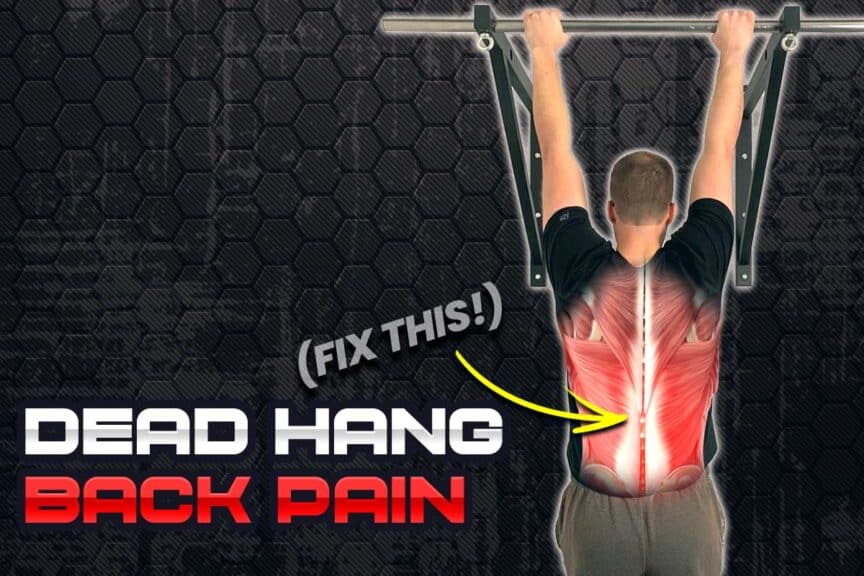A strong grip is a hallmark feature of a strong body, and few exercises build up your gripping power the way the dead hang does. And as you likely know, when you perform the dead hang, the only thing you should be feeling is the tension in your forearms and a bit of decompression through your spine; if you’re feeling pain anywhere in your back, something ain’t right.
But fear not; this article will provide key insight to point you in the right direction for getting this annoying (and surprisingly common) issue under control, allowing you to keep hangin’ for days – sans back pain.
Back pain from dead hangs is often the result of excessive traction force through the tissues of the lower back, fascial restriction, pelvic tilt position during the hang, and pre-existing conditions in the lower back. Solutions involve optimizing training protocols and fixing underlying issues.
The dead hang is an exercise worth doing, but only if it’s building your grip strength and improving your shoulder mobility.
So, if you’ve got back pain when hanging from the bar, this article is for you.
Let’s fix the issue.
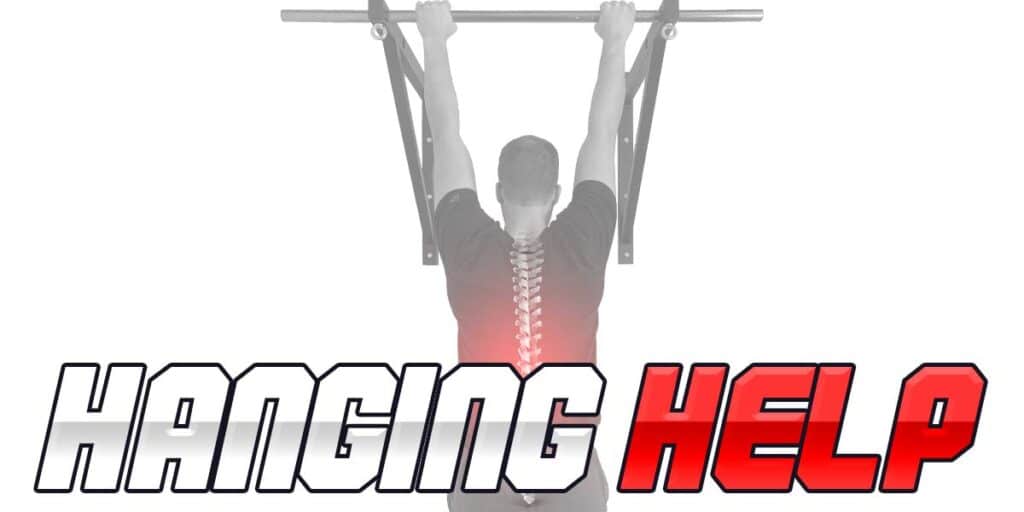
As we kick things off, keep in mind that your best bet for getting to the root cause of your pain or issue is to get an evaluation by a licensed and qualified healthcare professional, such as an orthopedic physical therapist.
For clarity and conciseness within this article, I have divided common causes for back pain with dead hangs into the regions of the spine they most often affect.
I’ve also included a section for issues commonly found in any region along the spine and back and a section for universal strategies that can help any region along your backside.
Related content:
Benefits of the dead hang exercise
To a lesser informed individual, the dead hang may not seem like an exercise worthy of pursuing, but it has three significant benefits, all of which are immensely important for your body:
- It tractions (decompresses) the spine and surrounding tissues.
- It improves shoulder and thoracic spine mobility.
- It builds up some seriously strong grip strength.
So, just because you have back pain when hanging doesn’t necessarily mean you should forego this exercise forever. Yes, you may have to modify or avoid it for the time being, but this can be a highly therapeutic exercise for many individuals, so it’s worth getting to the root cause of your pain so you can keep hanging from the bar (and reaping all the glorious benefits) for all your days ahead.
Global: back and spine issues
The issues in this section apply to any region along your spine; they’re commonly seen in the upper, middle, and lower back. Read the following section carefully, as it will give you a general starting point for navigating through common causes for experiencing back pain when hanging from the bar.
Be sure to check out the solutions section immediately afterwards for strategies you can consider implementing once you’ve read the following common issues below.
Issue 1: Excessive traction of the spine
When it comes to traction (decompression) of the spine, there can certainly be too much of a good thing; while it generally feels therapeutic to have the back and spine receive gentle traction (being pulled apart, if you will), too much pulling can be perceived as a threat by any sensitive tissues in the area, leading to pain.
In particular, the resulting stretch may be a bit too much for the nerves in your back, particularly if they have become extra sensitive (which can happen for a variety of reasons) and are not used to undergoing this type of stretch.
Fun fact: When nerves become extra sensitive to being stretched or become extra sensitive to movement, it’s known as mechanosensitization of the nerve.
This is a surprisingly common issue, and it’s often incredibly easy to clean up; you’ll just need to ease into your dead hangs for a week or two and slowly increase the traction force within each dead hang session you perform. You’ll learn more about strategies for doing this later on in the article.
Issue 2: Fascial restriction of back muscles
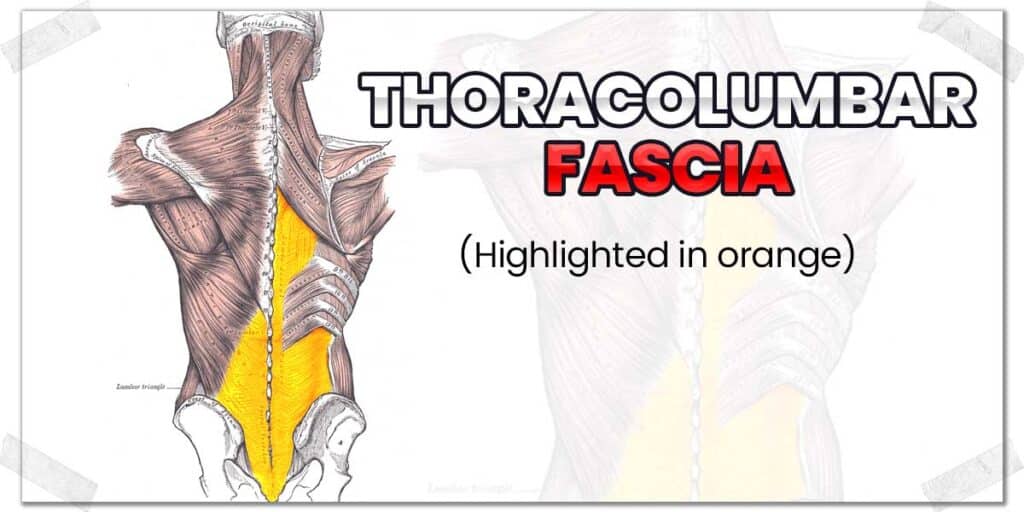
When it comes to stretching (such as tractioning the spine through the dead hang), sometimes nerves aren’t the issue, but rather the fascia.
Fascia is a type of dense connective tissue (made of collagen) within the body. It surrounds and covers our muscles and serves as a sort of glue to hold everything together. When operating as intended, this fascia should easily glide and slide within the body and not impede muscle or movement function in the process. Unfortunately, like any other tissue in the body, it can become dysfunctional, leading to all sorts of issues.
Fascial dysfunction is quite common and can arise for various reasons, including:
- Injury to the muscles/affected body part
- Postural deformity (ex. sitting in a slouched position all day long)
- Lack of adequate movement (not moving enough, not moving in a specific direction, etc.)
When fascial dysfunction is present, it can result in:
- Loss of mobility through the affected region
- Pain or stiffness when the affected region is moved
- Reduced or poor movement ability and poor functional or athletic performance
Now, why am I making such a big deal about fascia? Simple answer: because of the massive amounts of fascia along the back, most notably the thoracolumbar fascia (which you’ll learn more about shortly).
For the time being, you simply need to be aware that fascia runs all along your back, wrapping and covering every muscle. As such, fascial dysfunction along the upper, middle, and especially lower back is very common. Thankfully, it is often a straightforward approach to restoring fascial mobility.
Working on restoring and optimizing the fascia along your back can be done in many ways, either through the assistance of a qualified healthcare professional (physical therapist, massage therapist, osteopath, etc.) or by yourself through active movements (stretches, yoga, foam rolling, etc.). Whichever you choose (based on what’s most practical or feasible for your needs and situation), give it some consistent effort (at least a few times per week), and you’ll likely start to feel notable improvements within a few weeks.
Read solution 2 in the following section for further information.
Global: Back pain solutions when hanging from the bar
Whether you’re experiencing pain in your upper, middle, or lower back as you hang, the solutions below can be an effective starting point for getting things back under control. These generalized solutions can work quite well for most individuals. If you want or need specifics pertaining to your upper, middle, or lower spine, check out the following sections after this one.
Solution 1: Ease into your hangs
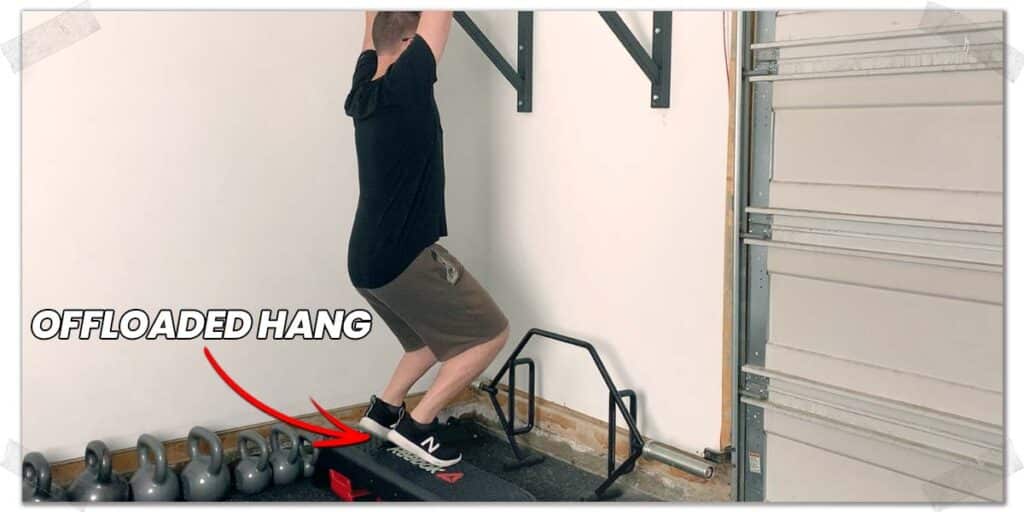
If you’ve recently started performing the dead hang and aren’t used to tractioning your spine, it may be worth easing into your hangs for a week or two as a means to let your back and spine accommodate to the stretch it’s receiving.
There could be numerous ways to do so, two of which could be:
- Perform the full dead hang but for shorter durations.
- Perform the dead hang with a bit of foot support beneath you to offload the extent of traction.
- Some combination of the above two strategies.
Experimenting with any of these strategies could allow you to slowly build into a full-on prolonged dead hang that provides you with pain-free decompression (and better grip strength) without irritating your back in the process.
Solution 2: Optimize your fascial mobility
One of my personal favorite strategies (since pretty much everyone can benefit from fascial work along their backside). And, realistically, even if your back is feeling fine, you should be doing some fascial work throughout your body regularly as a form of preventative maintenance.
There are numerous ways you can start to take action against any fascial dysfunction along your back, but they can essentially be divided into two categories:
Category 1: Professional treatment
Category 2: Self-treatment
Regarding professional treatment, this can look like getting a massage from a massage therapist or treatment from a similarly qualified healthcare specialist, such as an orthopedic physical therapist.
Effective fascial techniques can include:
- IASTM (Instrument Assisted Soft Tissue Mobilization)
- Myofascial cupping techniques
- Skin rolling and fascial sweeping techniques
Professional treatment can absolutely make a profound difference in the fascial mobility and function in your back (or elsewhere in the body), but it may not be in the cards for every individual, depending on access to professionals, available time, financial resources, etc.
When it comes to traction of the spine, there can be too much of a good thing; while it can feel therapeutic for the spine to receive gentle traction, too much pulling can be perceived as a threat by any nearby sensitive tissues, leading to pain.Click to PostThis is where self-treatment comes in, which can still yield very notable improvements in fascial health. It can be a bit limiting in how you can treat your own back, but some preliminary things to try include:
- Heating (via laying on a heating pad) and thereafter performing stretches and dynamic movements once your back has been warm for at least ten minutes.
- Laying on an acupressure mat on a regular basis.
- Foam rolling (or using a harder roller) for your middle and upper back.
There’s plenty of great information online on how to effectively perform any of these strategies, so a quick search in the ol’ Google or YouTube search bar should yield some rather helpful results.
Solution 3: Train grip through other means
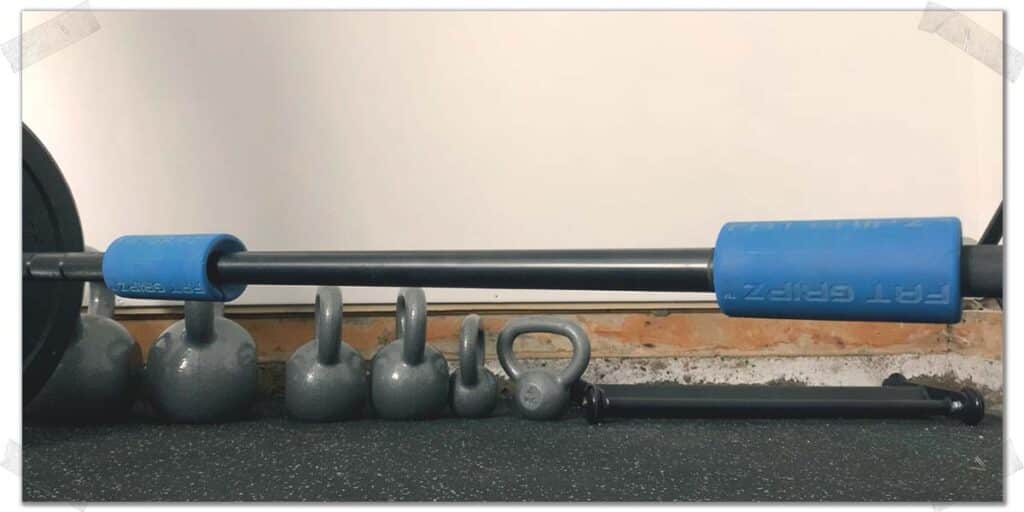
This solution only comes into play if you’ve been performing your dead hangs to improve grip strength (but are limited by your back pain).
It may just be that as you work to uncover the root cause of your back pain that you temporarily switch to another form of grip strengthening exercises.
Related article: Straps vs Mixed Grip When Deadlifting (Pros & Cons of Each)
Some of my favorite grip-strengthening exercises similar to the dead hang are:
- Timed barbell holds (holding the top position of the deadlift)
- Farmers walks/carries
- Fat Gripz holds (on a barbell or dumbbells)
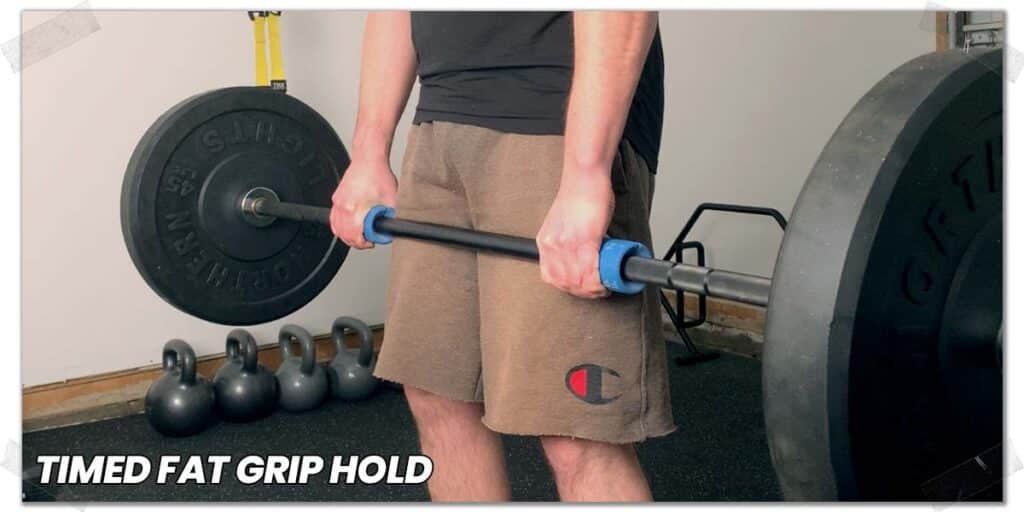
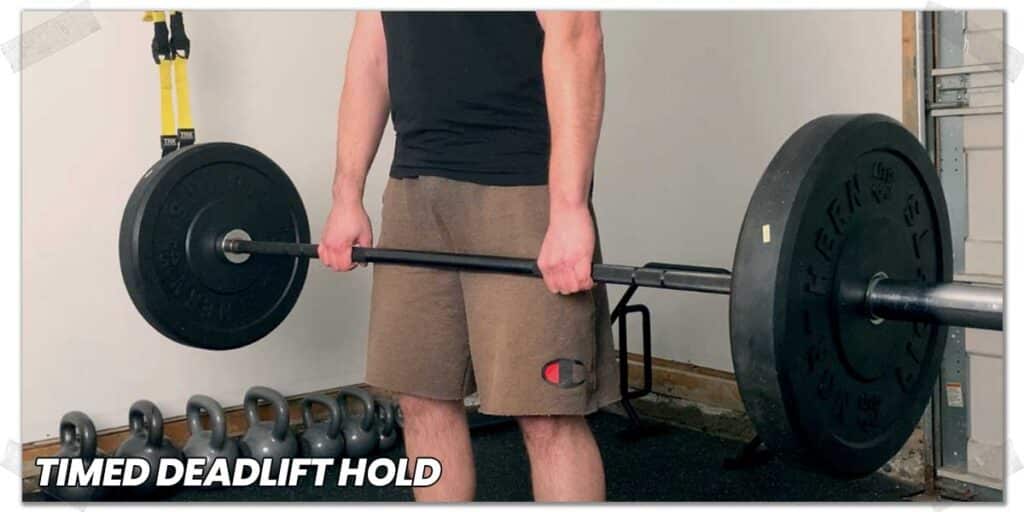
There’s no shortage of ways to train your grip strength, but the above exercises work rather well since they allow you to hold a similar (or greater) amount of weight as the dead hang itself.
So, it might be worth switching from the dead hang for a few weeks until your back gets under control, then ease back into the dead hang (strategy 1) once ready.
Specifics: Lumbar spine (lower back) issues
Now it’s time to get into the specifics of the back and spine. Most people I’ve talked to who have experienced back pain when doing the dead hang have experienced it in their lower back, so let’s start here, and then we can look at issues in the thoracic (middle and upper) spine after that.
Issue 1: Anterior pelvic tilt (facet issues, excessive hip flexor stretching)
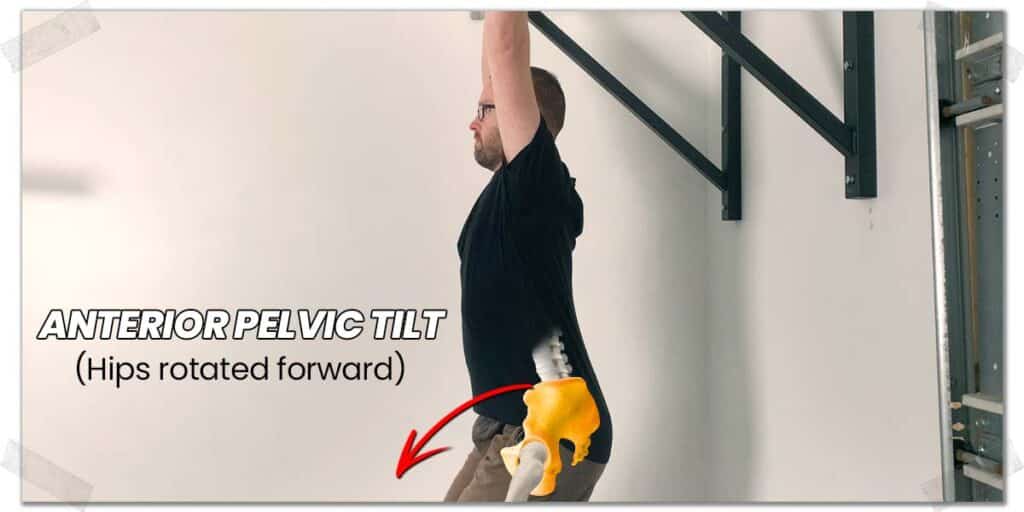
One of the biggest issues I’ve seen causing back pain when hanging from a bar (be it for the dead hang, chin-ups, pull-ups, etc.) is due to letting the lower body move into a high degree of anterior pelvic tilt.
Anterior pelvic tilt refers to the hip bones rotating forwards, which leads to the arching of the lumbar spine (the bottom five bones of the vertebrae).
Hanging from a bar with a large anterior pelvic tilt can irritate the lumbar facet joints, often producing a sharp, pinching, or stabbing sensation. I’ve written extensively about this in my article on why people have sore abdominal muscles after doing pullups, so head over there if you want to get the full rundown on how the facets and other structures in the back can be affected when hanging in this position.
The cause of excessive anterior tilt is the result of low abdominal tone/engagement of your abdominal muscles (most notably the rectus abdominis muscle). When this muscle contracts, it rotates the hips backwards (a posterior pelvic tilt), which flattens out the lumbar spine.
The solution: When you hang from the bar, keep your abdominal muscles engaged so that your lower back stays in a neutral position and doesn’t arch. The bonus here is that it will also give you a nice little abdominal workout as you hang!
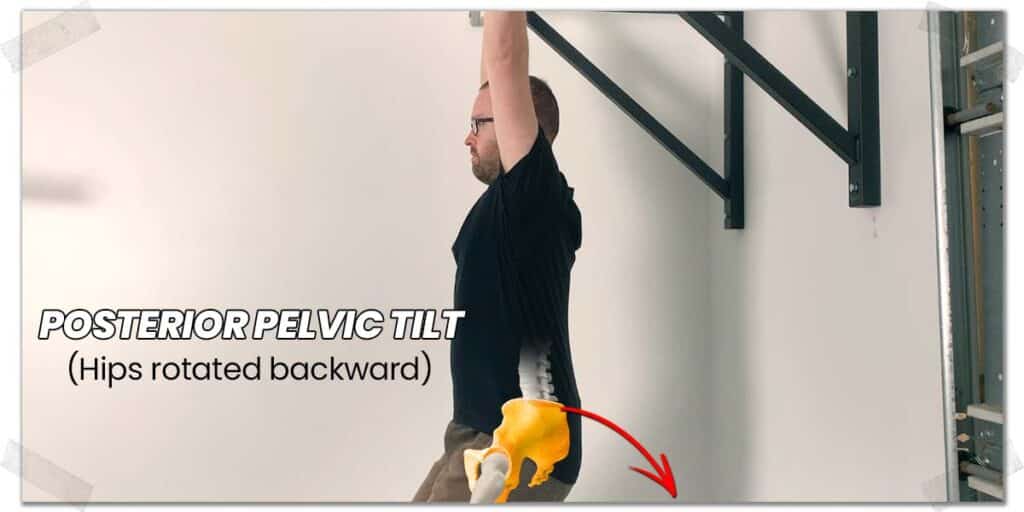
Issue 2: Thoracolumbar fascial dysfunction
The thoracolumbar fascia consists of multiple layers of fascial tissue that help separate lower back muscles into distinct compartments while also helping to transmit forces and loads throughout the body. It is thickest around the lumbar spine region and plays a substantial role in overall back health.
As mentioned earlier in the article, fascia can become restricted and dysfunctional, leading to all sorts of aches and pains, such as when it’s undergoing stretch while hanging from a bar.
The solution: Getting professional fascial work done to the region or performing some therapeutic self-treatment to the fascia will be your best bet. Read solution 2 in the global section for more information.
Issue 3: Tight or immobile hip flexors
The hip flexor muscles (notably the psoas major and iliacus muscle) can potentially cause lower back pain when hanging from the bar if they are tight, unhealthy, or otherwise dysfunctional.
The psoas major is of particular note since it attaches to the transverse processes of the lumbar vertebrae, which can cause sensations of back pain if provoked, such as through a stretch greater than it can adequately tolerate.
If you’re performing the dead hang exercise with excessive anterior pelvic tilt, the hip flexors will undergo a large stretch, which may be pain or discomfort-provoking if they lack the capacity to stretch into this position.
The solution: Work on your hip flexor mobility (stretches & dynamic movement) while maintaining a neutral lower spine (keep a posterior pelvic tilt) or even a slightly flexed hip position to avoid provoking your hip flexors through an aggressive stretch.
Specifics: Thoracic spine (mid-upper back) issues
The thoracic spine refers to the twelve vertebrae beneath the seventh cervical vertebra (the bottom of the neck) and above the first lumbar vertebra.
If you’ve been experiencing back pain between the bottom of your neck and the top of your lower back region, this is the section for you.
Issue 1: Lacking thoracic spine extension

Thoracic spine extension refers to the ability to straighten your spine, as when standing upright. The thoracic spine should always have a small curve (known as a kyphotic curve).
It’s not uncommon for individuals to lose mobility in their thoracic spine, particularly with thoracic extension (straightening the spine, as when standing upright).
Hanging from a bar requires the thoracic spine to move into extension, but if it’s stiff or immobile, it will likely lead to pain or discomfort. This is typically an issue with the thoracic facet joints, but it can also be due to poor mobility from other tissues.
The solution: Your best bet is to find ways to improve the mobility of your thoracic spine, particularly the facet joints, when moving into extension.
Simple self-treatment remedies can include:
- Performing foam rolling for your thoracic spine
- Performing the cat/cow exercise or thread-the-needle exercise
- Strength training your middle and upper back muscles (performing exercises such as TRX rows, dumbbell rows, and even goblet squats.
Issue 2: Lacking shoulder mobility
In an incredibly similar fashion to the thoracic spine, if your shoulder mobility is lousy, it may lead to pain in your middle or upper back when performing the dead hang. Your shoulders must be able to produce enough flexion to allow your arms to attain a vertical position (so you can grab and hold onto the bar).
If your shoulder mobility is lacking, it may lead to excessive tension or strain on some of the muscles that attach from your shoulder blade (the scapula) to the thoracic spine, leading to pain or discomfort in your back.
The more prominent muscles in this situation include:
- The rhomboid major and rhomboid minor
- The trapezius muscle (notably the middle and lower fibers)
As such, getting these (and any other associated muscles) mobility-based issues under control will likely be immensely helpful in taking care of any muscle-related middle or upper back discomfort you might be experiencing.
The solution: As with other issues outlined in this article, you can take an approach of enlisting the help of a qualified healthcare professional to help you out (massage therapist, physical therapist, etc.), or you can opt to work on your soft tissue mobility (the mobility of your muscles and tendons) by yourself.
If you opt to work on your shoulder and upper back mobility by yourself, here’s what you will likely want to consider:
- Improving muscular mobility is typically best addressed through a combination of various stretching techniques and strengthening exercises. Strengthening exercises that are performed through maximal (or large) ranges of motion will likely work best.
- Self-soft tissue treatments such as foam rolling, using acupressure mats, and heat can all be notably helpful, but you’ll need to fine-tune the parameters of how you employ each one to make it best suit you.
- Doubling up on professional help and performing various self-soft tissue treatments on yourself will likely yield the quickest and perhaps most notable benefits.
Final thoughts
Building up some serious grip strength while simultaneously decompressing your spine is a beautiful two-for-one scenario that will serve almost every lifter quite well. So, take the time required to get to the root cause of your back pain to effectively deal with the issue; you don’t want to forego the dead hang if you can help it (but you don’t want to push through pain, either).
Take the insight within this article and use it as a general starting point to taking the necessary action so that you can keep hanging for all your days ahead.
Hopefully, I’ll see you hangin’ around.
Frequently Asked Questions
To better serve my readers, I’ve included a few brief answers to some commonly asked questions that individuals have with the dead hang exercise. I hope they help answer any further questions you may have!

Hi! I’m Jim Wittstrom, PT, DPT, CSCS, Pn1.
I am a physical therapist who is passionate about all things pertaining to strength & conditioning, human movement, injury prevention and rehabilitation. I created StrengthResurgence.com in order to help others become stronger and healthier. I also love helping aspiring students and therapists fulfill their dreams of becoming successful in school and within their clinical PT practice. Thanks for checking out my site!

